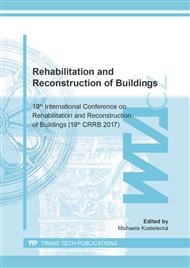[1]
M. Šomodíková, B. Teplý, D. Vořechovská, D. Lehký, Modelling of the service life of concrete structures under combined mechanical and environmental actions, Safety and Reliability of Complex Engineered Systems. Switzerland: L. Podofillini et al. 2015, 4219-4224.
DOI: 10.1201/b19094-552
Google Scholar
[2]
F. H. Wittmann, T. Zhao, F. Jiang, X. Wan, Influence of Combined Actions on Durability and Service Life of Reinforced Concrete Structures Exposed to Aggressive Environment, Restoration of Buildings and Monuments. 18, 2 (2012), 105-112.
DOI: 10.1515/rbm-2012-6510
Google Scholar
[3]
W. Piasta, J. Góra, T. Turkiewicz, Properties and durability of coarse igneous rock aggregates and concretes, Construction and Building Materials. 126 (2016) 119-129.
DOI: 10.1016/j.conbuildmat.2016.09.022
Google Scholar
[4]
J. A. Bogas, J. de Brito, D. Ramos, Freeze–thaw resistance of concrete produced with fine recycled concrete aggregates, Journal of Cleaner Production. 115 (2016) 294-306.
DOI: 10.1016/j.jclepro.2015.12.065
Google Scholar
[5]
K. Behfarnia, N. Salemi, The effects of nano-silica and nano-alumina on frost resistance of normal concrete, Construction and Building Materials. 48 (2013) 580-584.
DOI: 10.1016/j.conbuildmat.2013.07.088
Google Scholar
[6]
M. Collepardi, The New Concrete, first ed., Grafiche Tintoretto, Treviso, (2006).
Google Scholar
[7]
A. Neville, Properties of concrete, fifth ed., Pearson, New York, (2011).
Google Scholar
[8]
ASTM C666 / C666M-15, Standard Test Method for Resistance of Concrete to Rapid Freezing and Thawing, ASTM International, West Conshohocken, PA, (2015).
Google Scholar
[9]
ČSN 73 1322 Stanovení mrazuvzdornosti betonu, ÚHM, Praha, 1968 (in Czech).
Google Scholar
[10]
J. Newman, B. S. Choo, Advanced concrete technology: Concrete Properties, first ed., Elsevier, Amsterdam, (2003).
Google Scholar
[11]
L. Zarauskas, G. Skripkiūnas, G. Girskas, Influence of Aggregate Granulometry on Air Content in Concrete Mixture and Freezing - Thawing Resistance of Concrete, Procedia Engineering. 172 (2017) 1278-1285.
DOI: 10.1016/j.proeng.2017.02.153
Google Scholar
[12]
D. Kocáb, M. Králíková, P. Cikrle, P. Misák, B. Kucharczyková, Experimental analysis of the influence of concrete curing on the development of its elastic modulus over time, Mater. Technol. 51 (2017) 4, 657-665.
DOI: 10.17222/mit.2016.248
Google Scholar
[13]
ČSN 73 1380 Zkoušení odolnosti betonu proti zmrazování a rozmrazování - Porušení vnitřní struktury, ČNI, Praha, 2007 (in Czech).
Google Scholar


